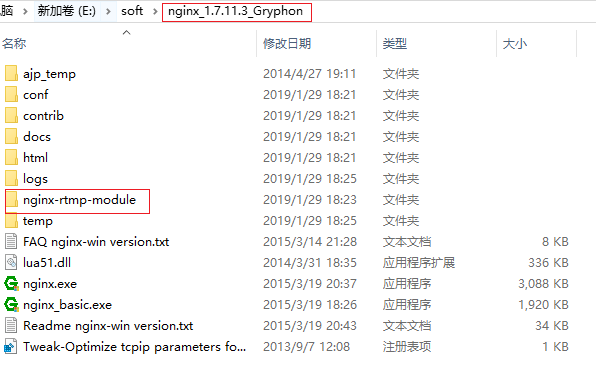为了让大家少踩笔者踩过的坑,目前将工作中搭建rtmp推流服务器的步骤总结如下:
步骤1: 下载 nginx 1.7.11.3 Gryphon
下载链接: http://nginx-win.ecsds.eu/download/nginx 1.7.11.3 Gryphon.zip,下载完成后解压, 将解压后的目录命名为nginx_1.7.11.3_Gryphon
(此处注意千万不要命名为nginx-1.7.11.3-Gryphon,笔者初次搭建rtmp推流服务器时,将解压后的目录命名为nginx-1.7.11.3-Gryphon,出现局域网内的其他电脑都无法访问rtmp服务器的问题,也是花了一天的时间填坑,将主文件名改为nginx_1.7.11.3_Gryphon时,其他电脑才能正常访问。为神马会如此,笔者也是疑问,好歹问题无意间解决了)
步骤2:下载服务器状态检查程序 stat.xsl(注:直接clone到nginx-1.7.11.3-Gryphon目录下)
下载地址https://github.com/arut/nginx-rtmp-module/
此时的目录结构如下图所示:

步骤3:配置文件 conf\nginx-win-rtmp.conf 内容如下:

#user nobody;# multiple workers works !worker_processes 2;#error_log logs/error.log;#error_log logs/error.log notice;#error_log logs/error.log info;#pid logs/nginx.pid;#worker_rlimit_nofile 100000; #更改worker进程的最大打开文件数限制
#如果没设置的话, 这个值为操作系统的限制.
#设置后你的操作系统和Nginx可以处理比“ulimit -a”更多的文件
#所以把这个值设高, 这样nginx就不会有“too many open files”问题了events {
worker_connections 8192;#设置可由一个worker进程同时打开的最大连接数
#如果设置了上面提到的worker_rlimit_nofile, 我们可以将这个值设得很高
# max value 32768, nginx recycling connections+registry optimization =
# this.value * 20 = max concurrent connections currently tested with one worker
# C1000K should be possible depending there is enough ram/cpu power
# multi_accept on;}
rtmp {
server {
listen 1935;#监听端口,若被占用,可以更改
chunk_size 4000;#上传flv文件块儿的大小
application live { #创建一个叫live的应用
live on;#开启live的应用
allow publish 127.0.0.1;# allow play all;
}
}
}
http { #include /nginx/conf/naxsi_core.rules; include mime.types;
default_type application/octet-stream; #log_format main '$remote_addr:$remote_port - $remote_user [$time_local] "$request" '
# '$status $body_bytes_sent "$http_referer" '
# '"$http_user_agent" "$http_x_forwarded_for"';
#access_log logs/access.log main;# # loadbalancing PHP# upstream myLoadBalancer {# server 127.0.0.1:9001 weight=1 fail_timeout=5;# server 127.0.0.1:9002 weight=1 fail_timeout=5;# server 127.0.0.1:9003 weight=1 fail_timeout=5;# server 127.0.0.1:9004 weight=1 fail_timeout=5;# server 127.0.0.1:9005 weight=1 fail_timeout=5;# server 127.0.0.1:9006 weight=1 fail_timeout=5;# server 127.0.0.1:9007 weight=1 fail_timeout=5;# server 127.0.0.1:9008 weight=1 fail_timeout=5;# server 127.0.0.1:9009 weight=1 fail_timeout=5;# server 127.0.0.1:9010 weight=1 fail_timeout=5;# least_conn;# }
sendfile off; #tcp_nopush on;
server_names_hash_bucket_size 128;## Start: Timeouts ##
client_body_timeout 10;
client_header_timeout 10;
keepalive_timeout 30;
send_timeout 10;
keepalive_requests 10;## End: Timeouts ##
#gzip on;
server {
listen 8088;
server_name localhost; #charset koi8-r;
#access_log logs/host.access.log main;
## Caching Static Files, put before first location
#location ~* \.(jpg|jpeg|png|gif|ico|css|js)$ {
# expires 14d;
# add_header Vary Accept-Encoding;
#}# For Naxsi remove the single # line for learn mode, or the ## lines for full WAF mode
location / { #include /nginx/conf/mysite.rules; # see also http block naxsi include line
##SecRulesEnabled;
##DeniedUrl "/RequestDenied";
##CheckRule "$SQL >= 8" BLOCK;
##CheckRule "$RFI >= 8" BLOCK;
##CheckRule "$TRAVERSAL >= 4" BLOCK;
##CheckRule "$XSS >= 8" BLOCK; root html;
index index.html index.htm;
}# For Naxsi remove the ## lines for full WAF mode, redirect location block used by naxsi
##location /RequestDenied {
## return 412;
##}## Lua examples !# location /robots.txt {# rewrite_by_lua '# if ngx.var.http_host ~= "localhost" then# return ngx.exec("/robots_disallow.txt");# end# ';# }
#error_page 404 /404.html;
# redirect server error pages to the static page /50x.html
# error_page 500 502 503 504 /50x.html;
location = /50x.html {
root html;
} # proxy the PHP scripts to Apache listening on 127.0.0.1:80
# #location ~ \.php$ {
# proxy_pass http://127.0.0.1;
#}
# pass the PHP scripts to FastCGI server listening on 127.0.0.1:9000
# #location ~ \.php$ {
# root html;
# fastcgi_pass 127.0.0.1:9000; # single backend process
# fastcgi_pass myLoadBalancer; # or multiple, see example above
# fastcgi_index index.php;
# fastcgi_param SCRIPT_FILENAME $document_root$fastcgi_script_name;
# include fastcgi_params;
#}
# deny access to .htaccess files, if Apache's document root
# concurs with nginx's one
# #location ~ /\.ht {
# deny all;
#} } # another virtual host using mix of IP-, name-, and port-based configuration
# #server {
# listen 8000;
# listen somename:8080;
# server_name somename alias another.alias;
# location / {
# root html;
# index index.html index.htm;
# }
#}
# HTTPS server
# #server {
# listen 443 ssl spdy;
# server_name localhost;
# ssl on;
# ssl_certificate cert.pem;
# ssl_certificate_key cert.key;
# ssl_session_timeout 5m;
# ssl_prefer_server_ciphers On;
# ssl_protocols TLSv1 TLSv1.1 TLSv1.2;
# ssl_ciphers ECDH+AESGCM:ECDH+AES256:ECDH+AES128:ECDH+3DES:RSA+AESGCM:RSA+AES:RSA+3DES:!aNULL:!eNULL:!MD5:!DSS:!EXP:!ADH:!LOW:!MEDIUM;
# location / {
# root html;
# index index.html index.htm;
# }
#}}步骤4:启动服务器
nginx.exe -c conf\nginx-win-rtmp.conf
步骤5:使用推流地址
推流地址:rtmp://lP:监听端口/应用名/home,步骤3配置文件配置出的推流地址为rtmp://192.168.xxxx.xxxx:1935/live/home
通过此推流地址,便可以成功推流
步骤6:其他ngnix常用命令:
(1)终止服务器
nginx.exe -s stop
stop是快速停止nginx,可能并不保存相关信息;
nginx.exe -s quit
quit是完整有序的停止nginx,并保存相关信息。
(2)重新载入Nginx
nginx.exe -s reload
当配置信息修改,需要重新载入这些配置时使用此命令。
(3)重新打开日志文件
nginx.exe -s reopen
本文链接:https://kinber.cn/post/806.html 转载需授权!
推荐本站淘宝优惠价购买喜欢的宝贝:


 支付宝微信扫一扫,打赏作者吧~
支付宝微信扫一扫,打赏作者吧~


